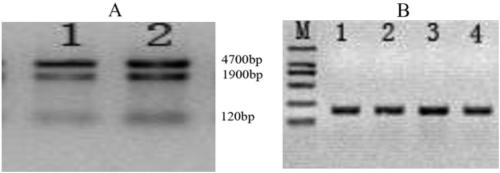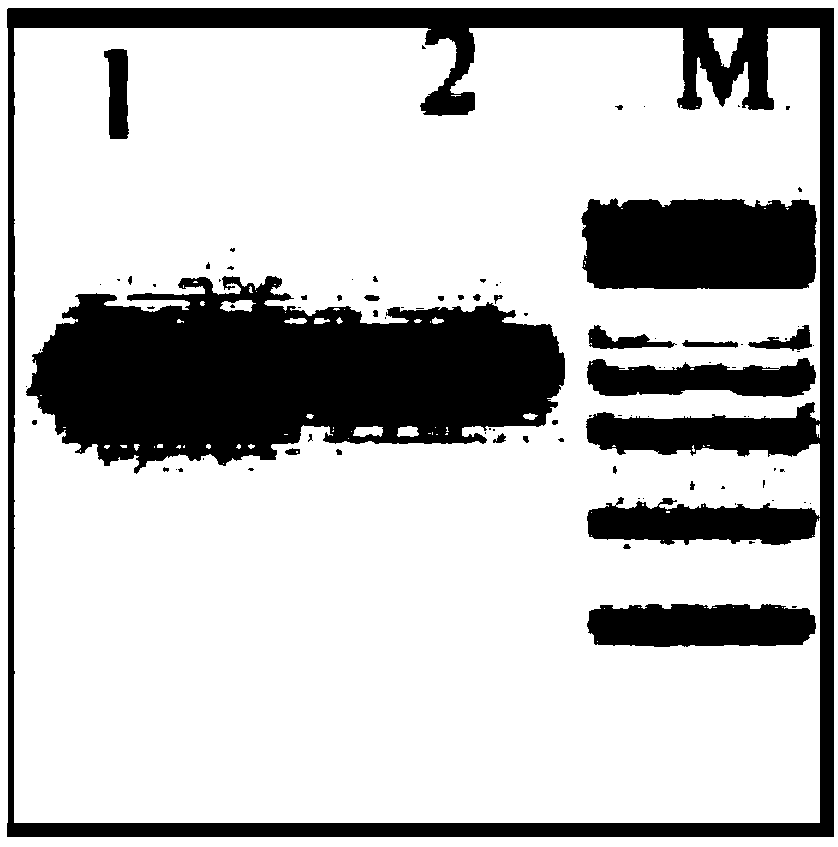Corn Zm-APX gene molecular marker, obtaining method and application in stalk rot control
A corn stalk rot and molecular marker technology, applied in application, horticultural methods, genetic engineering and other directions, can solve the problems of not finding resistance genes, limiting the improvement of corn varieties, etc., and achieving the effect of increasing stalk rot resistance
- Summary
- Abstract
- Description
- Claims
- Application Information
AI Technical Summary
Problems solved by technology
Method used
Image
Examples
Embodiment 1
[0045] Embodiment 1 A kind of cloning method of Zm-APX gene, concrete steps are as follows:
[0046] Step 1, using RNA extraction reagent TRIZOL Reagent to extract total RNA from leaves of maize inbred line B73, and obtain maize total RNA for future use. Detected by 1.5% agarose gel electrophoresis, the results are shown in Figure 1A, figure 1 Lanes 1 and 2 in A are the total RNA of corn, including 28S and 18S, which are the large and small subunits of the ribosome, and the bottom band is 5.8S and 5S (because the length difference is not large, 5.8S and 5S are difficult to distinguish in electrophoresis), indicating that the RNA integrity is good and can be used for follow-up experiments.
[0047] Step 2, extraction of maize genomic DNA
[0048] Maize genomic DNA was extracted with a plant genomic DNA extraction kit (Tiangen) for later use.
[0049] Step 3, cDNA first-strand synthesis and detection
[0050] (1) Synthesis of the first strand of cDNA
[0051] According to t...
Embodiment 2
[0071] Example 2 Preparation of the Zm-APX transgenic strain whose nucleotide sequence is shown in SEQ ID NO.10
[0072] Utilize the molecular marker Zm-APX gene whose nucleotide sequence is shown in SEQ ID NO.10 to construct an overexpression vector capable of stably expressing Zm-APX, and then transform the overexpression vector into Agrobacterium competent cells to obtain transformation Bacteria, and finally use the transformed bacteria to transform corn plants to obtain positive transgenic lines with resistance to corn stalk rot. Specific steps are as follows:
[0073] S1, preparation of Agrobacterium competent cells, Zm-APX gene solution
[0074] Take a single colony of Agrobacterium GV3101 (commercially available) in 3ml of YEB liquid medium, shake and culture overnight at 28°C; take 2ml of the overnight culture solution and inoculate it in 100ml of YEB liquid medium, shake at 28°C until the OD600 is 0.5-0.8 (about 3-4h); 4°C, centrifuge at 5000rpm / min for 10min, colle...
Embodiment 3
[0086] Real-time fluorescence quantitative PCR detection of embodiment 3Zm-APX transgenic strain
[0087] Get 243, 241 negative strains and 235, 236 positive strains obtained in Example 2, extract corn total RNA with reference to the method in Example 1 step 1, then synthesize 243, 241 negative strains and 241 negative strains and The cDNA first strands of 235 and 236 positive strains were then used for fluorescent quantitative PCR.
[0088] Fluorescent quantitative PCR target gene primers:
[0089] Zm-APX F7: 5'-CATCGCCGAGAAGAGCT-3', as shown in SEQ ID NO.15, Zm-APX R7 5'-GGGAACTCCTCCTTGAT-3', as shown in SEQ ID NO.16; PCR amplification fragment 183bp;
[0090] Fluorescence quantitative PCR internal reference gene 18S primer:
[0091] 18S R8: 5'-CCTGCGGCTTAATTGACTC-3', as shown in SEQ ID NO.17,
[0092] 18S F8: 5'-GTTAGCAGGCTGAGGTCTCG-3', as shown in SEQ ID NO.18; the PCR amplified fragment is 174bp.
[0093] The fluorescent quantitative PCR system is as follows: Premix T...
PUM
 Login to View More
Login to View More Abstract
Description
Claims
Application Information
 Login to View More
Login to View More - R&D
- Intellectual Property
- Life Sciences
- Materials
- Tech Scout
- Unparalleled Data Quality
- Higher Quality Content
- 60% Fewer Hallucinations
Browse by: Latest US Patents, China's latest patents, Technical Efficacy Thesaurus, Application Domain, Technology Topic, Popular Technical Reports.
© 2025 PatSnap. All rights reserved.Legal|Privacy policy|Modern Slavery Act Transparency Statement|Sitemap|About US| Contact US: help@patsnap.com



